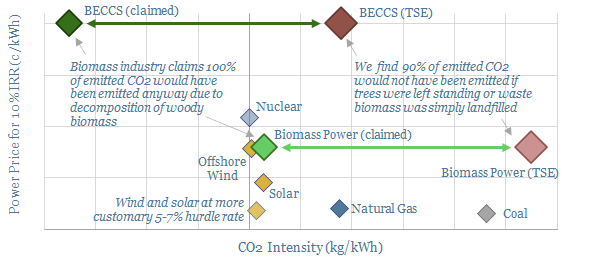20% of Europe’s renewable electricity currently comes from biomass, mainly wood pellets, burned in facilities such as Drax’s 2.6GW Yorkshire plant. But what are the economics and prospects for biomass power as the energy transition evolves? This 18-page analysis leaves us cautious.
Arguments in favor of biomass are outlined on pages 2-3, using the carbon cycle to show how biomass could be considered zero-carbon in principle.
Examples of biomass power plants are described on pages 4-5, focusing upon Drax and RWE, and drawing upon data from 340 woody biomass facilities in US power.
The economics of producing biomass pellets are presented on pages 6-7, including a detailed description, capex breakdown, and critique of input assumptions.
The economics of burning biomass pellets to generate electricity are presented on pages 8-9, again with a detailed description and critique of input assumptions.
The economics of capturing and disposing of the CO2 are presented on pages 10-12, allowing us to build up a full end-to-end abatement cost for BECCS.
Energy economics are disaggregated on pages 13-14, in order to derive a measure of energy return on energy invested (EROEI) and CO2 intensity (in kg/kWh). Surprisingly, we find the EROEI for BECCS to be negative.
Is it sustainable? We answer this question on 15-17, arguing that biomass energy and BEECS, properly considered, both have a higher CO2 intensity than gas.
Conclusions and implications are presented on pages 18, including bridges for the total CO2 intensity of biomass and BECCS.

